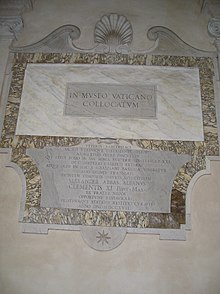
| Home | Sources Directory | News Releases | Calendar | Articles | | Contact | |
Catacombs
| This article needs additional citations for verification. Please help improve this article by adding reliable references. Unsourced material may be challenged and removed. (April 2008) |
Catacombs are ancient, human-made subterranean passageways for burial or protection.[1] Any chamber used as a burial place can be described as a catacomb, although the word is most commonly associated with the Roman empire.[2] Many are under cities and have been popularised by stories of their use as war refuges, smugglers' hideouts, or meeting places for cults.
Contents |
[edit] Etymology
The first place to be referred to as catacombs were the underground tombs between the 2nd and 3rd milestones of the Appian Way in Rome, where the bodies of the apostles Peter and Paul, among others, were said to have been buried. The name of that place in late Latin was catacumbae, a word of obscure origin, possibly deriving from a proper name, or else a corruption of the Latin phrase cata tumbas, "among the tombs". The word referred originally only to the Roman catacombs, but was extended by 1836 to refer to any subterranean receptacle of the dead, as in the 18th-century Paris catacombs.[3]
[edit] Around the world

Large and notable catacombs include:[clarification needed]
- Austria ' Catacombs of St. Stephen's Cathedral, Vienna
- Czech Republic ' Catacombs of Znojmo
- Egypt ' Catacombs of Kom el Shoqafa (or Kom al Sukkfa, Shuqafa, etc.) in Alexandria
- England ' various, see: Catacombs of London
- France ' Catacombs of Paris
- Ukraine ' Odessa Catacombs
- Italy ' various, see: Catacombs of Rome; Catacombs of Naples; Capuchin catacombs of Palermo
- Malta ' Rabat Catacombs[4]
- Peru ' Catacombs of the Convento de San Francisco, Lima
- Scotland ' Edinburgh Vaults
- Spain ' Catacombs of Sacromonte in Granada
There are also catacomb-like burial chambers in Anatolia, Turkey; in Sousse, North Africa; in Naples, Italy; in Syracuse, Italy; Trier, Germany; Kiev. Capuchin catacombs of Palermo, Sicily were used as late as 1920s. Catacombs were available in some of the grander English cemeteries founded in the 19th Century, such as Sheffield General Cemetery (above ground) and West Norwood Cemetery (below ground). There are catacombs in Bulgaria near Aladzha Monastery[citation needed] and in Romania as medieval underground galleries in Bucharest.[5]
In Ukraine and Russia, catacomb (used in the local languages' plural katakomby) also refers to the network of abandoned caves and tunnels earlier used to mine stone, especially limestone. Such catacombs are situated in Crimea and the Black Sea coast of these two countries. The most famous are Odessa Catacombs and Ajimushkay, Crimea, Ukraine. In the early days of Christianity, believers conducted secret worship services in these burial caves for safety and reverence for the dead. Later, they served as bases for Soviet World War II guerrillas (see also Great Patriotic War). Ajimushkay catacombs hosted about 10,000 fighters and refugees. Many of them died and were buried there, and memorials and museums were later established (it is now a territory of Kerch city).
[edit] Catacomb decorations
Catacombs although most notable for the underground passage ways and cemeteries are also the home of many decorations. There are thousands of decorations in the centuries old catacombs of Rome, catacombs of Paris, and other known and unknown catacombs, some of which include inscriptions, paintings and statues among other things such as ornaments which were placed in the graves over the years. Most of these decorations were used to identify, immortalize, and to show respect to the dead.
[edit] Inscriptions
Although thousands of inscriptions were lost as time passed, they still serve as an indication of the social rank or the job title of its inhabitants; most of the inscriptions simply indicate how loving a couple was, or the love of parents and such.
[edit] Paintings
Paintings can also be seen throughout the burial chambers on the walls and ceilings. The paintings conveyed the same ideas as the inscriptions found throughout the catacombs.
[edit] See also
[edit] References
- ^ "Catacomb - Definition and More from the Free Merriam-Webster Dictionary". Merriam-webster.com. 2007-04-25. http://www.merriam-webster.com/dictionary/catacomb. Retrieved 2010-05-20.
- ^ Other examples include a Neolithic Longbarrow, an Ancient Egyptian necropolis, or modern underground vaults such as the Catacombs of Paris.
- ^ Online Etymology Dictionary, "Catacombs", accessed 10 July 2010.
- ^ "Maltese Catacomb Complexes". UNESCO World Heritage Centre. http://whc.unesco.org/en/tentativelists/1113/. Retrieved 2008-04-17.
- ^ "Romania Libera:Network of tunnels under the capital city". http://www.romanialibera.ro/a71250/retea-strategica-de-buncare-si-tuneluri-dedesubtul-capitalei.html. Retrieved 2008-10-23.
Blyton, E. "Five go to Smuggler's Top" Hodder and Stroughton (1945) Éamonn Ó Carrag�¡in, Carol L. Neuman de Vegvar Roma felix: formation and reflections of medieval Rome Ashgate (14 March 2008) ISBN 978-0754660965 p. 33 [1] Nicholson, Paul Thomas (2005) "The sacred animal necropolis at North Saqqara: the cults and their catacombs" In Salima Ikram (ed) Divine creatures: animal mummies in Ancient Egypt. American University in Cairo Press, 2005 pp. 44'71. ISBN 978-9774248580
[edit] External links
| Wikimedia Commons has media related to: Category:Catacombs |
- The Catacombs of Naples
- The Catacombs of Paris
- The Catacombs of Saint Sebastian
- Catacombs
- The Catacombs of Saint Callist
- Subterranean Britannica
|
SOURCES.COM is an online portal and directory for journalists, news media, researchers and anyone seeking experts, spokespersons, and reliable information resources. Use SOURCES.COM to find experts, media contacts, news releases, background information, scientists, officials, speakers, newsmakers, spokespeople, talk show guests, story ideas, research studies, databases, universities, associations and NGOs, businesses, government spokespeople. Indexing and search applications by Ulli Diemer and Chris DeFreitas.
For information about being included in SOURCES as a expert or spokesperson see the FAQ or use the online membership form. Check here for information about becoming an affiliate. For partnerships, content and applications, and domain name opportunities contact us.


